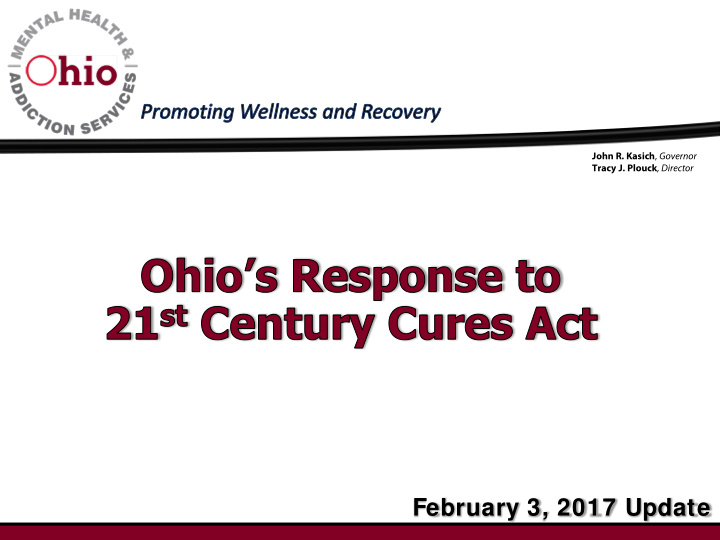



John R. Kasich , Governor Tracy J. Plouck , Director February 3, 2017 Update
• Resources to supplement current activities, increasing the ability of grantees to address the nation’s opioid crisis • Application is due February 17, 2017 • No cost-sharing or match required • Only Single State Agencies (SSAs) can apply • Funding period is up to two years • Ohio can be awarded a maximum of $26 million per year for two years 2
• I ncrease access to treatment, reduce unmet treatment need, and reduce opioid overdose- related deaths through the provision of prevention, treatment and recovery activities. • Supplement current opioid activities undertaken by the state. • Support a comprehensive response to the opioid epidemic using a strategic planning process to conduct needs and capacity assessments. 3
• Medication assisted treatment • Workforce development • Immediate access • Primary prevention • Screening, Brief Intervention, and Referral to Treatment (SBIRT) • Recovery supports, including peer • Addressing secondary trauma amongst first responders 4
• Treatment & Recovery Supports – up to $20m • Workforce augmentation • Targeted, immediate increases to Tx capacity • Primary Prevention – up to $5 m • Statewide training for evidence based practices • Targeted, immediate increases to prevention • Infrastructure/Administration – up to $1.3m • SBIRT • Vicarious trauma • Public-facing engagement • Jail data demonstration 5
6
• Tier 1: Counties with the highest overdose death counts (2010-2015), rates (2010-2015), and fentanyl deaths (2015). Total number of residents in Tier 1 Counties: 7,030,825, or 61% of state population. • Tier 2: Counties with the next highest overdose death rates (2010-2015), and need for treatment (NSDUH 2012-2014). Total number of residents in Tier 2 Counties: 1,678,383, or 14% of state population. • Tier 1 & Tier 2 totals: 8,709,208 Ohioans, or 75% of the state’s population, and 53% of counties and board areas 7
• Any lease beyond the project period; • Services to incarcerated populations; • Purchase or construction of any building or structure (applicants may request up to $75,000 for renovations and alterations of existing facilities, if necessary and appropriate to the project); • Housing other than residential mental health and/or substance abuse treatment; • Residential or outpatient treatment services when the facility has not yet been acquired, sited, approved, and met all requirements for human habitation and services provision (expansion or enhancement of existing residential services is permissible); and • Direct payments to individuals to induce them to enter or attend prevention or treatment services. 8
Recommend
More recommend